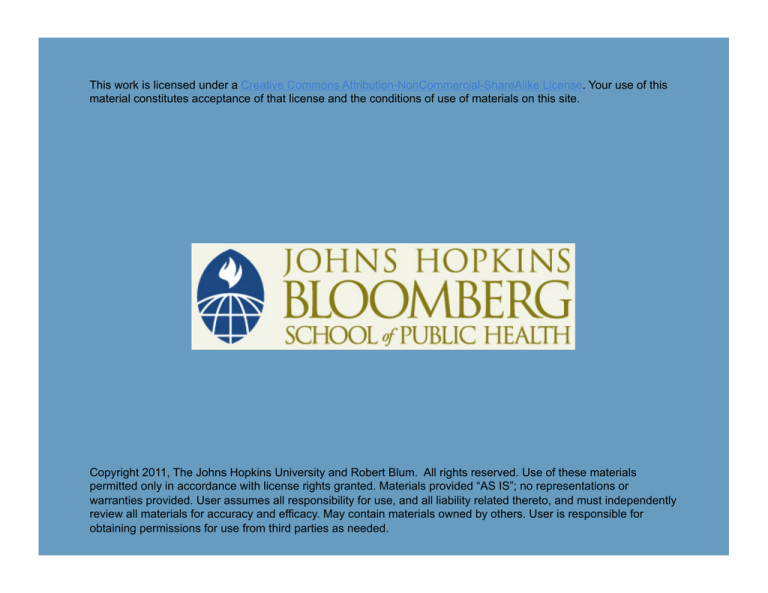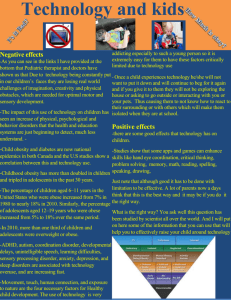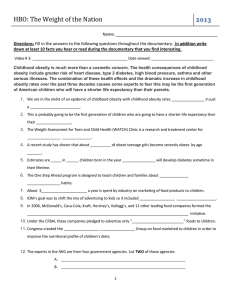
This work is licensed under a Creative Commons Attribution-NonCommercial-ShareAlike License. Your use of this
material constitutes acceptance of that license and the conditions of use of materials on this site.
Copyright 2011, The Johns Hopkins University and Robert Blum. All rights reserved. Use of these materials
permitted only in accordance with license rights granted. Materials provided “AS IS”; no representations or
warranties provided. User assumes all responsibility for use, and all liability related thereto, and must independently
review all materials for accuracy and efficacy. May contain materials owned by others. User is responsible for
obtaining permissions for use from third parties as needed.
Section C
Life Course Approaches to Obesity
Globally and Locally
Globally, 22 million children under 5 years of age are overweight;
10% of adolescents are overweight or obese
In the United States between the years 2000 and 2010, childhood
obesity increased by 0.5% per year; in Canada and England it has
increased by 1.0%
3
US Prevalence of Obesity, by Age (Bray, 2008)
Age
Percent
6–11 years old
18%
12–19 years old
17%
20–39 years old
30%
4
Obesity: Once Obese, Always Obese?
Obesity persistence
- 35% of of obese 5-year-olds become obese adults
- 75% of obese 11-year-olds are obese adults
- 90% of obese 17-year-olds are obese adults
5
The Four Components of a Life Course Perspective
1. Linked lives: parents’ choices, behaviors, and genetics effect their
children
2. Life events can be viewed as a trajectory: influences have a
differential impact at various stages of the life course
3. People have agency: individuals make choices influenced by the
social worlds in which they live (e.g., family, peers, neighborhood,
etc.)
4. Historical context matters: an historical perspective provides a
context for understanding current forces and factors
6
Factors Associated with Obesity across the Lifespan
What are the factors associated with obesity across the lifespan?
Consider the various stages
- Preconception
- Pregnancy
- Infancy
- Childhood
- Adolescence
- Adulthood
7
Preconception
Pre-pregnancy weight
Socio-economic status
Pre-pregnancy nutritional status
Maternal education
Historical events
8
Pregnancy
Maternal weight gain
Gestational diabetes mellitus
Maternal smoking
Poor prenatal nutrition (e.g., high sugars, low protein)
Maternal food preferences
9
Infancy
Low birth weight with rapid “catch up”
Breastfeeding
Infant formula and food supplementation
Maternal depression and caretaking
Eating patterns
Taste acquisition
10
Childhood
Genetics
- Syndromes
- Body type (adiposity rebound of middle childhood)
- Basal metabolic rate
Chronic diseases
- Medications
Food preferences and eating patterns
Food insecurity
11
Childhood—Parental Influences
Education
Feeding practices
Employment
Income
Attitudes toward food and nurturance
12
Childhood—The Environment
School
- Recess
- Physical education
- School meals, vending machines, treats
- Walkways and paths to school
Parks and recreation
Neighborhood safety
13
Childhood—The Environment
School
- Recess
- Physical education
- School meals, vending machines, treats
- Walkways and paths to school
Parks and recreation
Neighborhood safety
14
Childhood—Behaviors
TV viewing
- Advertising exposure
- Sedentary lifestyle
- Snacking
Eating behaviors (e.g., skipping breakfast)
Sports and activities
15
Adolescence
Puberty
Sleep patterns
Medications
- Antidepressants
- Oral contraception
- Antipsychotics
Substance use
- Marijuana
- Alcohol consumption
- Tobacco
School factors
Food preferences
16
Adolescence
Puberty
Sleep patterns
Medications
- Antidepressants
- Oral contraception
- Antipsychotics
Substance use
- Marijuana
- Alcohol consumption
- Tobacco
School factors
Food preferences
17
Adolescence
Depression
Medical conditions
Eating disorders and disordered eating
Employment
Activity level, sports participation
Eating as a social behavior
Peer networks and the contagion effect
18
Adult
Activity level
Consumption
Type of employment
Partner selection
Friendships and social networks
Menopause
Chronic diseases: lupus, thyroiditis, tumors
Alcoholism
Genetics (e.g., lymphatic rupture)
19
Obesity from a Life Course Perspective
20





